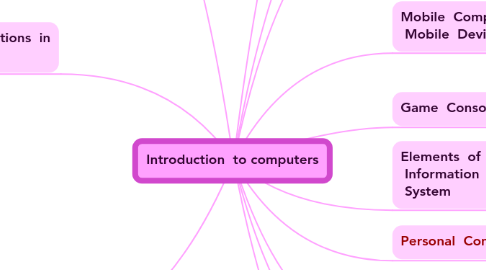Introduction to computers
by Kittin Foungnate

1. A world of computer
1.1. - Computers are everywhere.
2. Advantages and disadvantages of Using Computer
2.1. - Advantages of Using Computers • Speed • Reliability • Consistency • Storage • Communications - Disadvantages of Using Computers • Health Risks • Violation of Privacy • Public Safety • Impact on Labor force • Impact on Environment Advantages and Disadvantages of Using Computer - Green computing involves reducing the electricity consumed and environmental waste generated when using a computer. - Strategies Include • Recycling • Regulating manufacturing processes • Extending the life of computers • Immediately donating or properly disposing of replaced computers
3. Computer Applications in Society
3.1. - Education - Finance - Government - Health Care - Science - Publishing - Travel - Manufacturing
4. Objective Overview
4.1. - Explain why computer literacy is vital to success in today’s world. - Define the term computer, and describe the between data and information. - Describe the five components of a computer. - Discuss the advantages that users experience when working with computer. - Define the term network, and identify benefits of sharing resources on a network. - Discuss the uses of the internet and world wide web. - Distinguish between system software and application software. - Differentiate among types, sizes, and function of computer in the each category.
5. What is a Computer?
5.1. - A computer is an electronic device, operating under the control of instructions stored in it’s own memory.
6. The Components of a Computer
6.1. - Input Device • Allows you to enter data and instructions into a computer. - Output Device • Hardware component that conveys information to one or more people. - System Unit • Case that contain the electronic component of the computer that are used to process data. - Storage Device • Holds data, Instructions, and formation for future use. - Communications Device • Enables a computer to send and receive data instruction to and from one or more computer or mobile devices.
7. Networks and the Internet
7.1. - A network is a collection of computers and device connected together, often wirelessly , via communications device and transmission media. - The internet is a worldwide collection of networks that connects millions of businesses, government agencies, educational instructions, and individuals.
8. Computer Software
8.1. - Software, also called a program, tells the computer what tasks to perform and how to perform them. - Installing is the process of setting up software to work with the computer, printer, and other hardware.
9. Personal Computers
9.1. - A personal computer can perform all of It’s input, processing, output, and storage activities by itself. - Two popular architectures are the PC and the Apple. • Desktop computer
10. Mobile Computers and Mobile Devices
10.1. - Notebook computer - Tablet PC - Smart phone - PDA - Handheld computer - Portable media player - Digital camera
11. Game Consoles
11.1. - A game console is a mobile computing device designed for single-player or multiplayer video games Supercomputers - A supercomputer is the fastest, most powerful computer
12. Elements of an Information System
12.1. - Hardware - Software - Data - People - Procedures
13. Summary
13.1. - Basic computer concepts - Components of a computer - Networks, the internet and computer software - Many different categories of computers, computer users, and computer applications in society


